This isn’t a list of “hidden gems” or another roundup of “must-sees.” It’s a real overview of Andalucia—what it is, how it moves, and why people fall for it without needing to be told to.
Andalucia is Spain’s southern stretch: all sun and stone and shadow. A place where Moorish palaces still watch over plazas, villages cling to cliffs, and every meal comes with something you didn’t know you were craving. It’s not about rushing from city to city or checking boxes. It’s about letting the place unfold slowly, one tiled courtyard or olive grove at a time.
This guide walks you through the region’s main cities, how to get between them, where to stay (with a map to keep you sane), and the kinds of experiences that stick with you. Call it an overview if you want—but the good kind. The kind that leaves you ready to travel smarter, not just further.
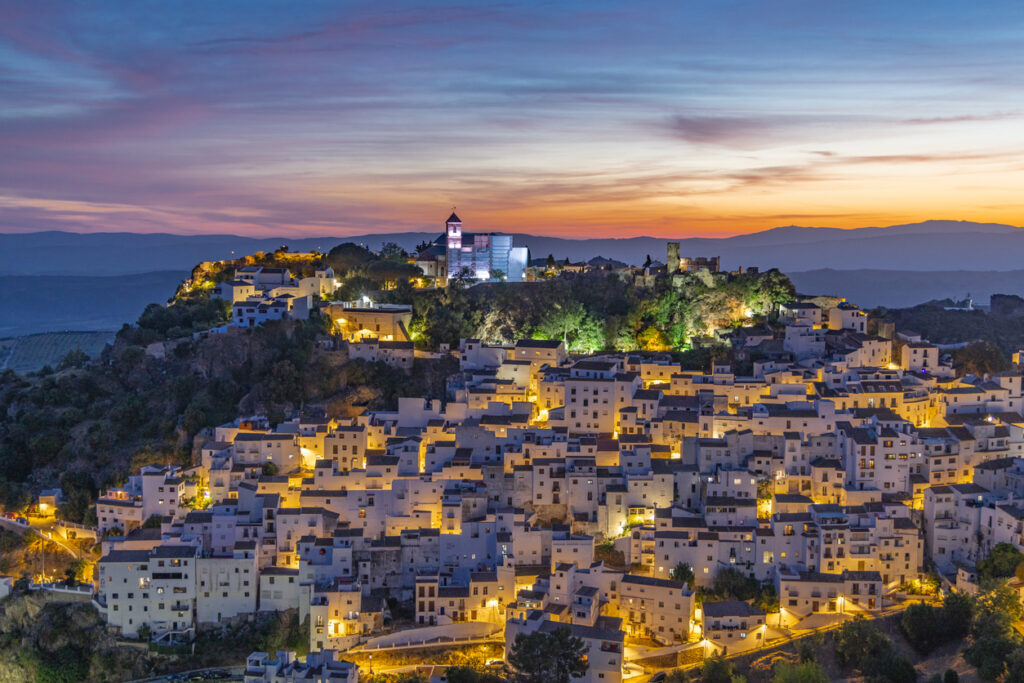
*Note some of the links feature affiliate links. I only recommend items that I 100% love and think you will too!
Seville doesn’t rush, but it never sleeps either. You get off the train, and suddenly it smells like orange blossoms and roasted almonds. The city moves with a rhythm you don’t need to understand—you just feel it. There’s flamenco in the bones of the place, and history that doesn’t sit behind glass cases but walks the streets with you.
What To Do
Start with the Real Alcázar, which looks like someone dared an architect to build paradise and they just… did. This palace is all intricate tiles, keyhole arches, and gardens that stretch on like a daydream. Then there’s the Seville Cathedral, which is not subtle about its size. Climb up La Giralda tower—ramps instead of stairs, built that way for horses—and catch the kind of view that makes you stay longer than you meant to.
Plaza de España is one of those spots that looks fake in pictures, but it’s not. Rent a little rowboat in the moat if you’re feeling theatrical. End your day across the river in Triana, the flamenco-heavy neighborhood where tiles, guitars, and strong opinions fly freely.
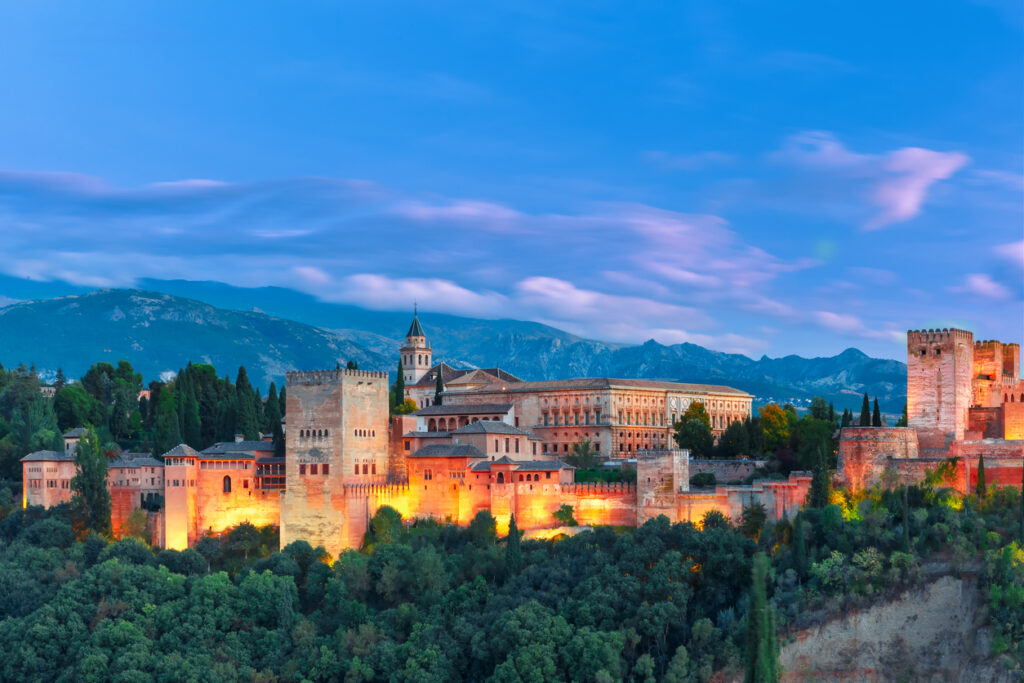
Granada: The Jewel of Moorish Spain
Granada is where Spain’s Moorish past doesn’t whisper—it sings. The city climbs the hills at the foot of the Sierra Nevada, each turn revealing something older, quieter, and unexpectedly alive. And yes, the Alhambra is as good as they say. Maybe better.
Plan ahead and get early tickets—it’s not the kind of place you want to rush. Between the Nasrid Palaces, the Generalife gardens, and the fortress views, you’ll understand what all the poetic fuss is about. Afterward, slip into the Albayzín. It’s not flat, but it’s worth it. Tea shops, echoing fountains, and streets too narrow for cars but perfect for wandering.
Before sunset, head to the Mirador de San Nicolás. Touristy? Sure. But the way the Alhambra glows against the snowy mountains? Worth every selfie stick in the crowd. Later, catch a flamenco show in Sacromonte—inside an actual cave if you can. It’s sweaty, raw, and unforgettable.
Free Andalucía Email Course: A Smarter Way to See the South
Andalucía isn’t just one place—it’s four (at least), and each one pulls in a different direction. Granada, Sevilla, Córdoba, Málaga… all worth it, but only if you move through them right.
This free email course gives you a clear, no-fuss plan for exploring southern Spain without the chaos of last-minute Googling. You’ll get:
- Transportation tips that actually work—train, car, timing, all of it
- What not to miss in each city: Sevilla, Granada, Córdoba, and Málaga
- Day trips that are doable—and don’t waste your whole day
- Must-have experiences that feel real, not staged
- A clear itinerary outline, with room to breathe and adjust
Before the course: You’re bouncing between open tabs, half-decided on where to stay, what to skip, and whether you need to book trains now or later.
After the course: You’ve got structure. You know where you’re going, what you’re seeing, and how to get there—without overpacking your trip or second-guessing every move.
It’s the difference between “what now?” and “this works.”👉 Join the free Andalucía email course here.
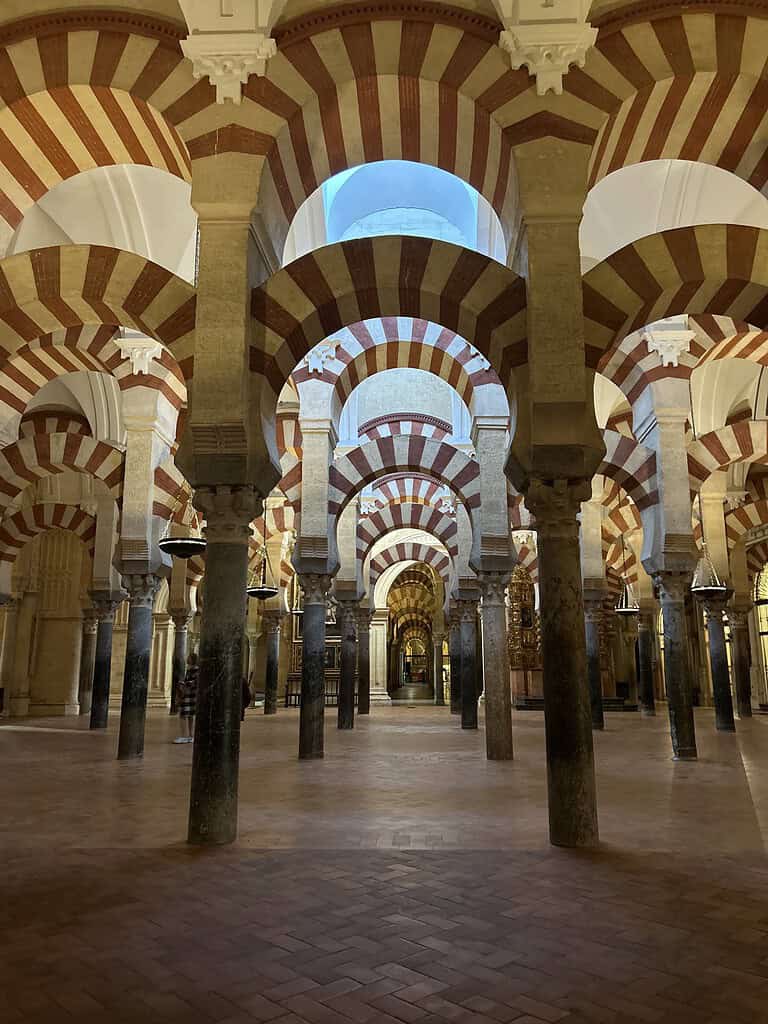
Córdoba: Where Cultures Collide
Córdoba was once the capital of the Islamic world in Europe. It still feels like a place where religions met, clashed, and somehow managed to coexist. The city doesn’t shout for your attention, but if you slow down, it reveals itself piece by piece.
The Mezquita-Catedral is the main event—an immense mosque that was later transformed into a cathedral. Sounds like a Frankenstein job, but it’s strangely seamless. Columns stretch in every direction like a stone forest. From there, stroll through the Jewish Quarter (Judería)—whitewashed walls, blue pots, and a calm you’ll wish you could bottle.
Make time for the Alcázar de los Reyes Cristianos, with its Moorish-style gardens and Roman mosaics that survived conquest and chaos. Then lose yourself in Calleja de las Flores, a narrow street with more flowers than actual walking space.
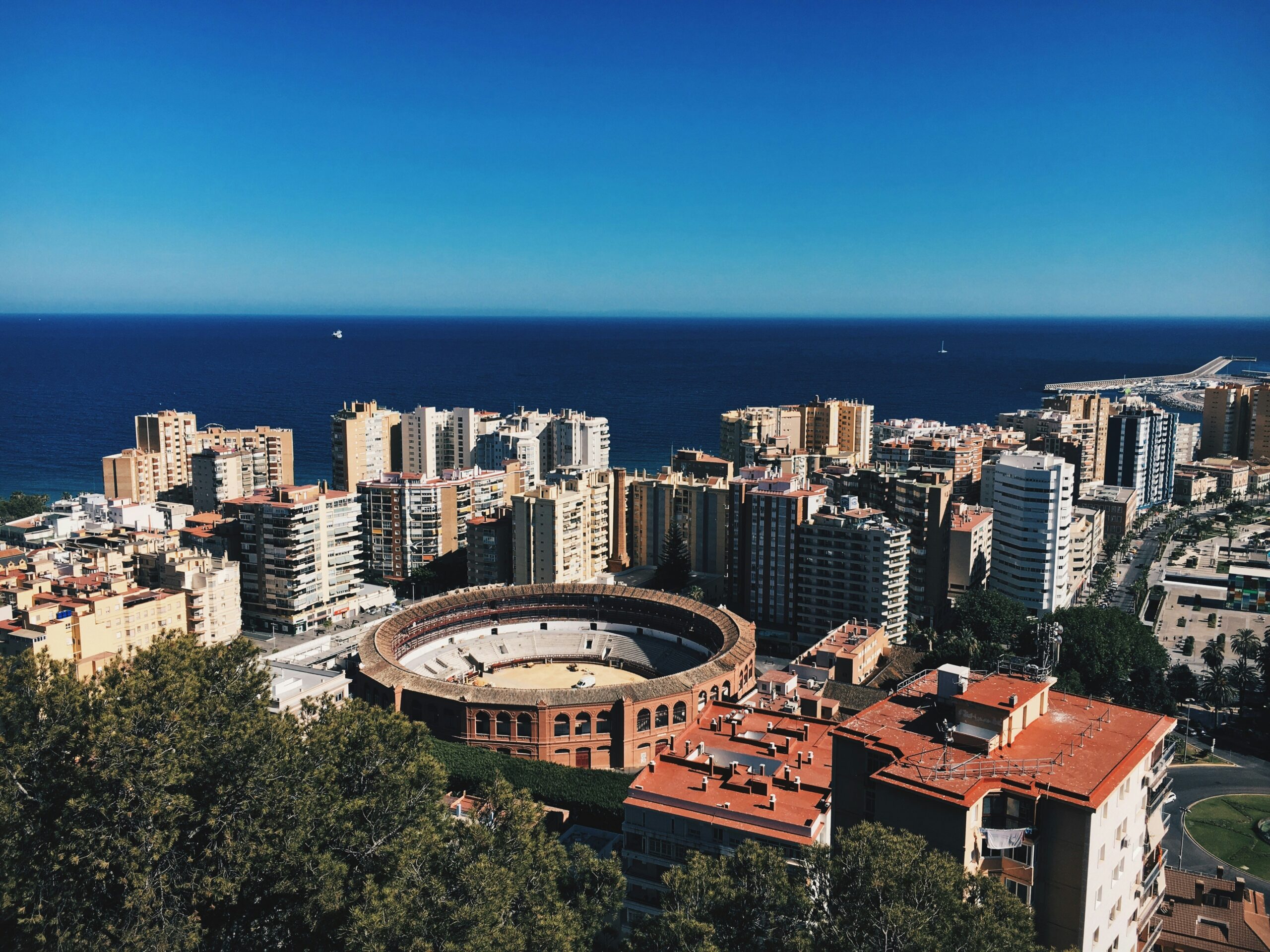
Málaga: Coastal Charm with Urban Buzz
Málaga used to be the flyover city—where people landed before bolting to the Costa del Sol. Not anymore. Now it’s a legitimate destination in its own right, and it wears its cultural revival like a well-cut linen jacket.
Start with the Picasso Museum—the man was born here, and the collection is surprisingly personal. Then climb up to the Alcazaba and Castillo de Gibralfaro, layered with Moorish walls and killer coastal views. There’s something about eating sardines on Malagueta Beach that just makes sense—especially when they’re grilled over open fire pits.
Later, walk into Soho, the neighborhood that went from grimy to gallery-chic without selling its soul. Street art spills out of the walls, and cafés here are less about posing and more about espresso that wakes you up properly.
Planning a Trip to Andalucia? Use This Map to Plan Your Stays
Booking a trip to Andalucia isn’t just about where you go—it’s about where you stay while you’re going. The right location can make your mornings smoother, your evenings quieter, and your whole trip feel less like logistics and more like living.
That’s where the map comes in.
Instead of clicking through pages of hotel listings and hoping for the best, use this map to figure out where it actually makes sense to sleep—based on walkability, vibe, access to trains, and how far you want to drag your suitcase after a long day.
This map shows you exactly where to stay in each major city—not just the neighborhoods, but the sweet spots within them. A few blocks off can be the difference between charming and chaotic.
- In Seville, you’ll want to choose between the postcard beauty of Santa Cruz, the lived-in soul of Triana, or the quiet efficiency of Nervión.
- In Granada, check out Albaicín if you like character and hills, Centro for flat and easy, and Realejo for something more local.
- In Córdoba, the Judería puts you in the thick of history, while Centro keeps things practical, and the Roman Bridge area gives you breathing room.
- In Málaga, you’ll decide between the energy of Centro Histórico, the edge and creativity of Soho, or the beach-town calm of Pedregalejo.
- In Ronda, stay in the Old Town for views or go rural with a cortijo and wake up to olive trees and stillness.
Use the map to zoom in, check your walking distances, and plan smarter stays—before you book a place you regret. Less guesswork. Better mornings. That’s the idea.
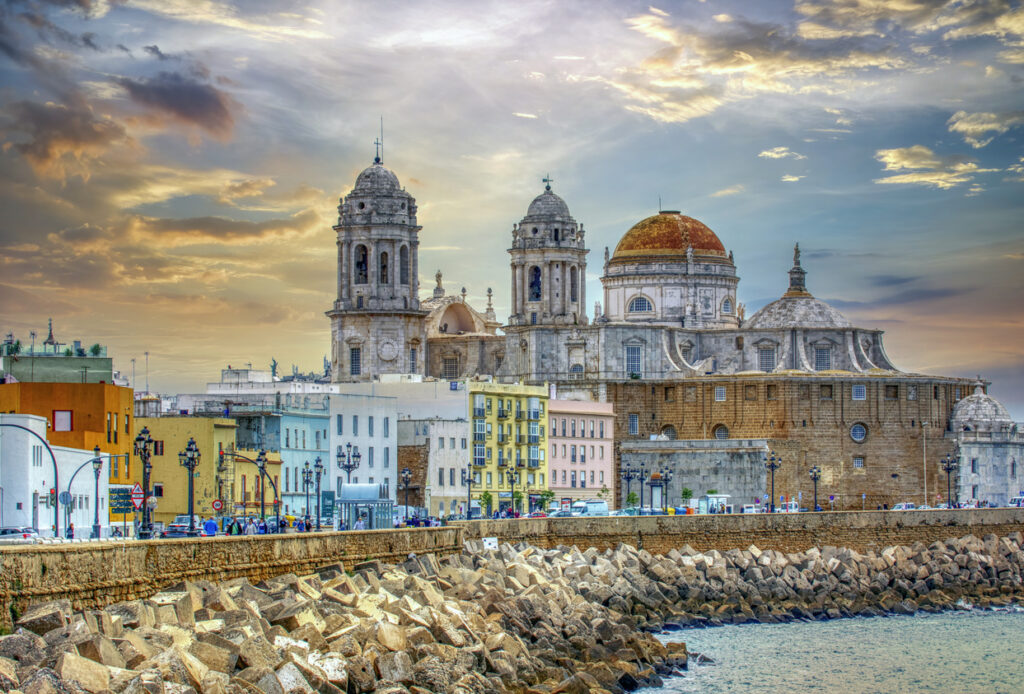
Cádiz: The Atlantic’s Ancient Playground
Cádiz has been around the block—literally. It claims the title of the oldest city in Western Europe, and it wears that age well. But this isn’t a museum in disguise. Cádiz is salty, sun-drenched, and full of locals who know how to throw a party (see: their legendary February Carnival).
Start with the Cádiz Cathedral, which towers over the sea like it’s guarding secrets. Climb the dome if your legs are up for it—those ocean views are the reward. Then there’s La Caleta, a small beach where old men fish at dawn and kids kick soccer balls until sunset. Tavira Tower has a camera obscura that lets you spy on the city in real time—yes, it’s a little touristy, but also very cool.
Cádiz is walkable, unpredictable, and brimming with charm you don’t have to earn. It just gives it to you.
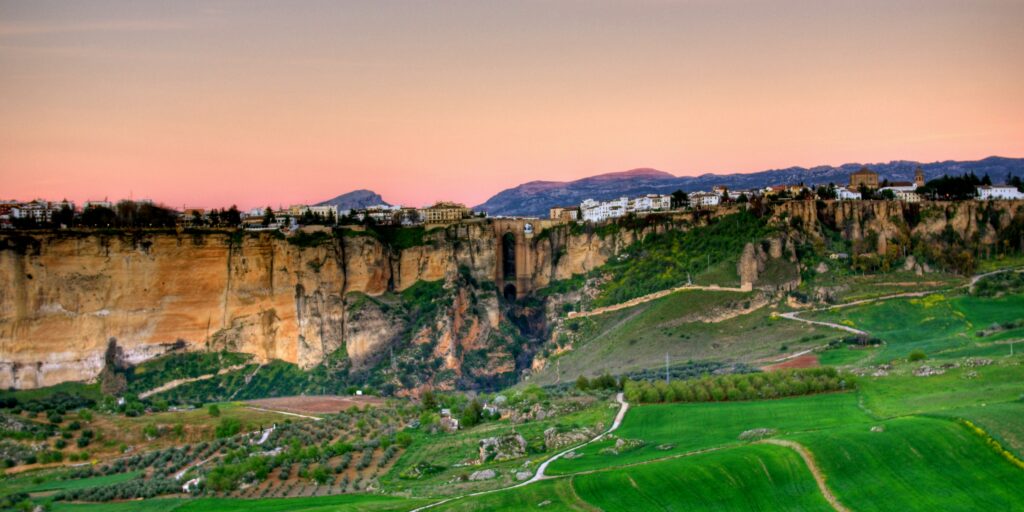
Ronda: Where Drama Meets Stone
Ronda is what happens when someone carves a city into a canyon and then builds a bridge so grand it becomes a symbol of Spanish romanticism. It’s dramatic and rugged, and somehow still feels intimate. This is the kind of place Hemingway would write about—and did.
Walk across Puente Nuevo, which spans a gorge so deep your stomach might notice before your brain does. On one side: the old town, quiet and timeless. On the other: shops, bars, and Spain doing what Spain does. The Plaza de Toros is one of the oldest bullrings in the country, and even if you’re not into bullfighting, the history and architecture are worth the visit.
From here, take a side trip to the Pueblos Blancos—white villages clinging to hillsides like they were painted there. Grazalema and Zahara are favorites, but honestly, you can’t go wrong.
If you want to do a road trip, check out this itinerary.
The Planner That Keeps You Traveling, Not Scrambling
There’s a fine line between feeling inspired and feeling overwhelmed. Planning a trip to Andalucia can take you down more rabbit holes than you meant to—especially when all you really want is to know where to go, how long to stay, and what’s actually worth your time.
That’s why I put together this Digital Travel Planner. It’s practical, clean, and built to work in the real world—whether you’re planning a slow week in three cities or trying to squeeze magic out of a long weekend. You’ll find curated itineraries, no-nonsense hotel picks, transport tips, food recs, and quiet reminders of why you’re doing this in the first place.
Because when the details are handled, you can actually enjoy the trip. The good moments. The accidental ones. The ones you remember.
If that sounds like your kind of guide, you’ll find it here.
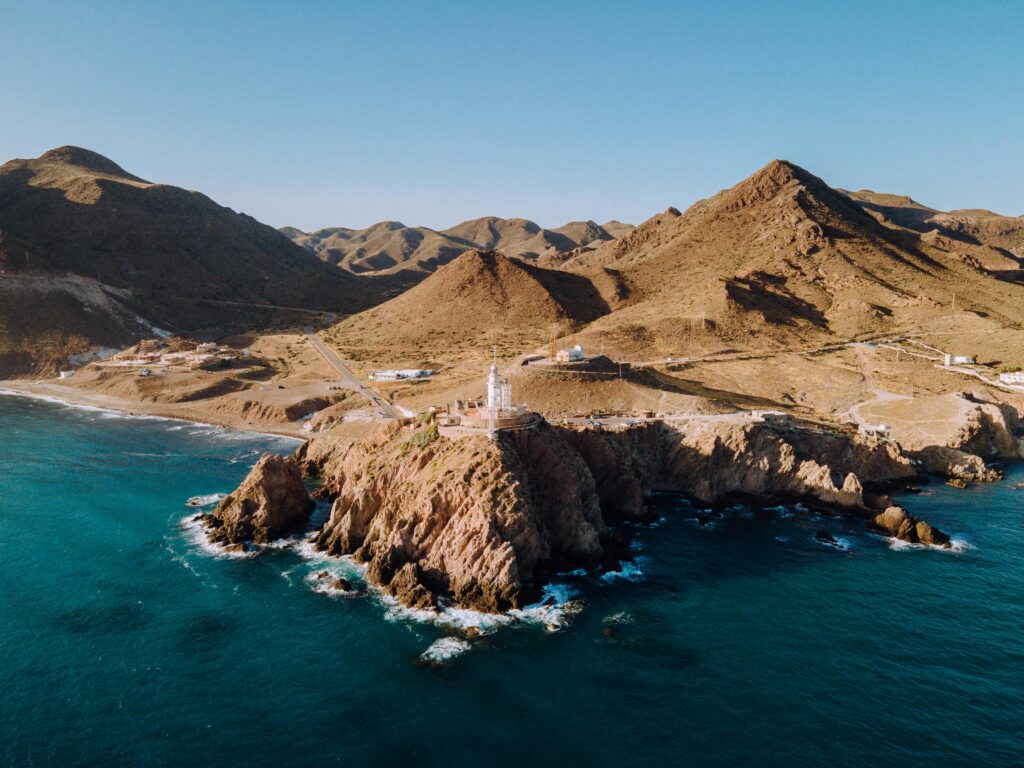
Almería: Spain’s Wild West Coast
Almería doesn’t try to be pretty. It doesn’t have to. It’s dry, desolate, occasionally windswept—and totally captivating. Think spaghetti westerns, fortress walls, and beaches with not a lifeguard or umbrella in sight.
Start with the Alcazaba, a fortress larger than the one in Granada and way less crowded. From there, head out to Tabernas Desert, where they filmed old-school cowboy flicks—and yes, you can still visit the fake towns. But the real gem is Cabo de Gata: untouched coastline, volcanic cliffs, and water so clear you’ll think it’s been Photoshopped.
Almería is for travelers, not tourists. If that’s you, you’ll dig it.
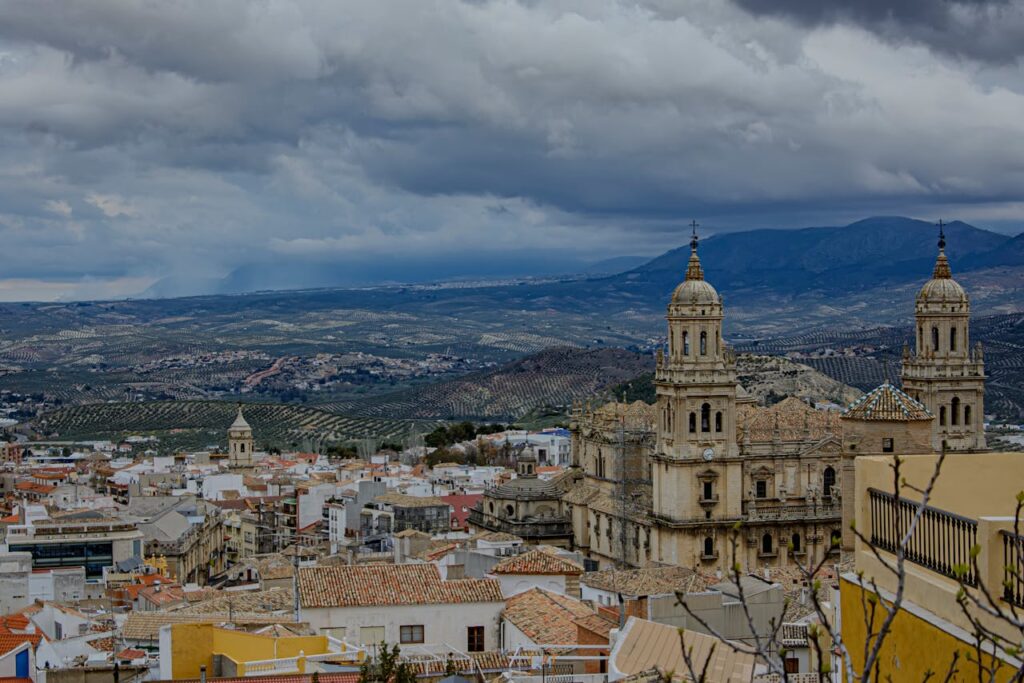
Jaén: Olive Oil, Castles, and Zero Crowds
Jaén might not be on your radar, and that’s kind of the point. It’s the underdog of Andalucia—low-key, laid-back, and home to more olive trees than people. If you care about food, landscapes, and places that don’t try to impress you, make the detour.
The Santa Catalina Castle looms over the city like something from a storybook, and the Jaén Cathedral is wildly underrated—elegant, spacious, and often blissfully empty. Rent a bike or just wander the Vía Verde del Aceite, a converted railway path that cuts through olive groves for miles.
Also: don’t leave without tasting olive oil fresh from a local co-op. It’ll ruin the supermarket kind for you.
Huelva: Where Nature Gets Its Way
Huelva is Andalucia’s wildcard. You won’t find lines, loud souvenirs, or rushed selfie-takers here. What you will find: wide-open wetlands, seafood that never needed a passport, and one of Europe’s most important ecological preserves.
Doñana National Park is the star—home to flamingos, lynxes, and everything in between. You can explore by jeep, boat, or just hike into the horizon. La Rábida Monastery ties in Columbus history if you’re into that. And the Marismas del Odiel wetlands? Birdwatcher heaven.
It’s quiet here. Purposefully so. And sometimes, that’s exactly what you need.
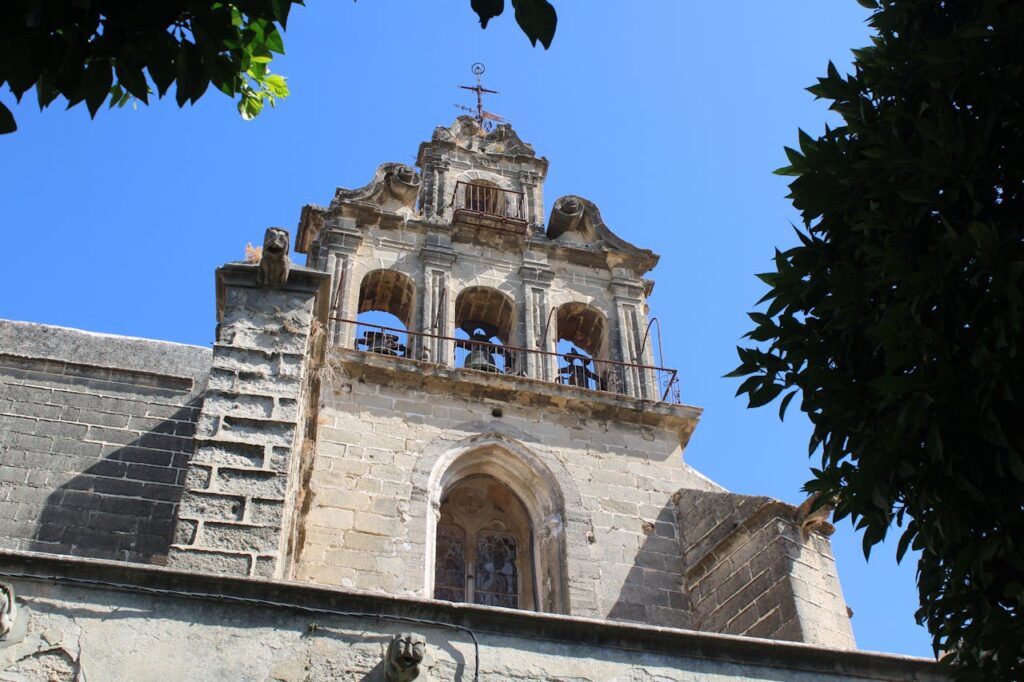
Jerez de la Frontera: Sherry and Swagger
In Jerez, they age their wine slowly and dance flamenco like it’s a form of survival. This city is pure Andalucian essence—less polished than Seville, but all the more real for it.
Start with a tasting at a bodega like Tío Pepe. Yes, it’s a bit of a tourist magnet, but the sherry is legit. Then swing by the Royal Andalusian School of Equestrian Art, where horses move like ballerinas and no one apologizes for it. In the evening, catch a flamenco show that feels like you’re being let in on a secret.
Jerez doesn’t flex. It just is. And that’s the charm.
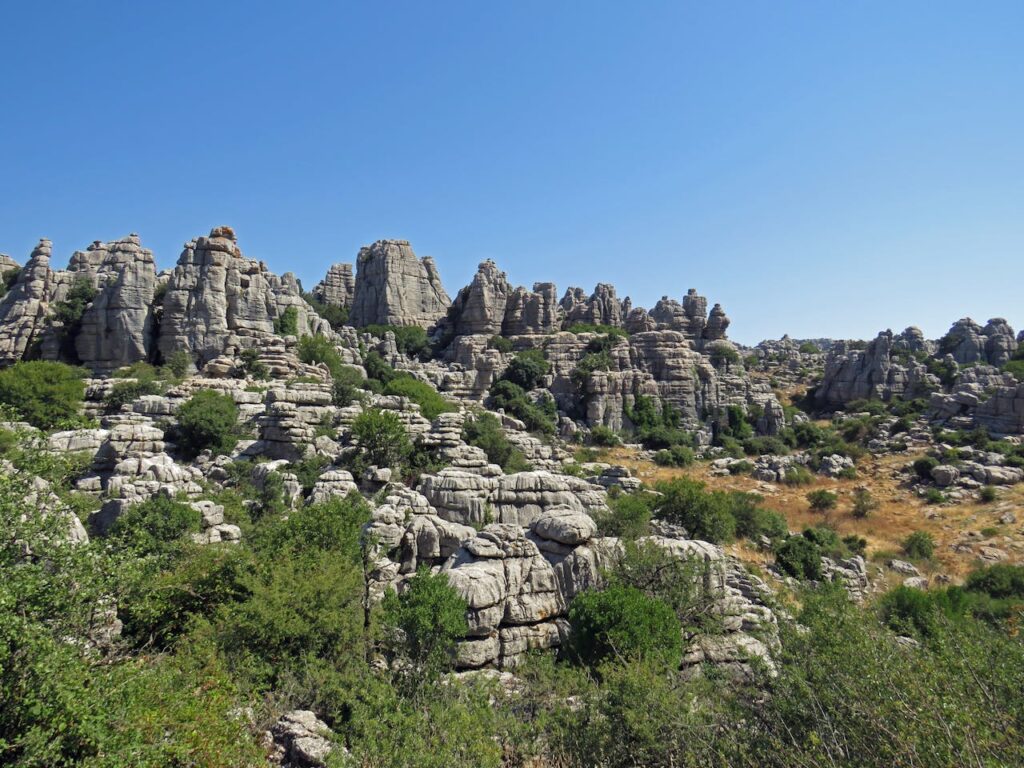
Antequera: Small City, Big History
Antequera isn’t on every itinerary, but it probably should be. It sits at the heart of Andalucia geographically—and kind of culturally too. It’s got castles, ancient tombs, weird rock formations, and zero pretense.
The Dolmens—giant Neolithic burial chambers—are older than Stonehenge and somehow still not swarmed with visitors. El Torcal Natural Park looks like another planet—limestone formations shaped by wind and time. Add in the Alcazaba and some seriously underrated tapas, and you’ve got a place that punches well above its weight.
Getting Around Andalucia: Choosing the Right Pace
Andalucia is wide open and well connected—but how you move through it matters. This isn’t a region you want to rush. The distances between cities are manageable, but the real beauty lies in how the journey feels, not just how fast you can get from A to B.
Trains are ideal for major routes. The high-speed AVE connects Seville, Córdoba, Málaga, and Granada with comfort and efficiency. It’s smooth, reliable, and often faster than flying once you factor in airport time. If you plan ahead, you can find good prices, especially with the Renfe Spain Pass.
Buses fill in the gaps. Companies like ALSA and Avanza cover towns and villages the trains don’t reach. They’re slower, but often scenic, and still a good option if you’re going off the usual grid.
Driving gives you the most freedom, especially in the countryside or along the coast. Want to meander through white villages or pull over when the landscape surprises you? Rent a small car. Just be prepared for tight streets in old towns and make sure your accommodation has parking—many city centers don’t.
Walking isn’t just for city exploring. In Andalucia, the best views often come after a bit of a climb or a quiet morning ramble. Leave space in your schedule for those unplanned, slower moments. They’re often the ones that stick.
There’s no “one way” to travel Andalucia. Choose what matches your pace, your curiosity, and your comfort. This is a region that rewards attention, not speed.
The Best 10-Day Itinerary (No Regrets Route)
If you’ve got 10 days, you can cover serious ground without burning out. Here’s how to do it right:
Day 1–3: Seville
Start in the capital. See the Alcázar, get lost in Santa Cruz, eat your weight in jamón.
Day 4–5: Ronda + White Villages
Head south. Stay in Ronda. Do a loop through Grazalema, Zahara, and Setenil.
Day 6–8: Granada
Alhambra in the morning, tapas crawl at night. Day trip to the Alpujarras or Sierra Nevada if you’re feeling spry.
Day 9–10: Málaga
Coastal unwind. Museums, beaches, and enough food to make you miss your flight home.
Alternate routes: swap Ronda for Córdoba if you’re short on time, or add a night in Cádiz if the sea is calling louder than the mountains.
Day Trips That Don’t Feel Like Chores
Seville:
- Itálica: Roman ruins with gladiator vibes. Game of Thrones fans, you know.
- Carmona: Charming, mellow, older than it looks.
- Doñana National Park: Bird nerd heaven.
Granada:
- Alpujarras: Mountain towns and air you’ll wish you could bottle.
- Sierra Nevada: Ski or hike, depending on the season.
Málaga:
- Frigiliana: Just… go. Pretty, perfect, not overrun.
- Caminito del Rey: That narrow cliff trail with guardrails and adrenaline.
- Antequera: Dolmens, rock gardens, and no bus tours in sight.
Unique Experiences That Stick
Some memories don’t need souvenirs. They’re etched in your senses.
- Watch a flamenco show in a Sacromonte cave (Granada). Real, raw, and probably off-beat. That’s the point.
- Taste fresh olive oil in Jaén. You’ll wonder why you ever settled for “extra virgin” in plastic bottles.
- Ride a hot air balloon over Ronda. Not cheap, but neither is therapy.
- Crash a village fiesta. Everyone’s welcome. No one’s faking it.
Best Time to Go (And When to Stay Home)
Spring (April–June): Orange blossoms, warm days, festival season. Andalucia in full bloom.
Fall (September–November): Still warm, fewer crowds, great for hiking and slow travel.
Winter: Snow in the Sierra Nevada, sunshine on the coast. No bad choices.
Summer (July–August): Unless you’re a lizard or love siestas, reconsider. It gets hot. Like, “why did I leave the hotel room” hot.
The Food: Yes, It’s As Good As You’ve Heard
Andalucia doesn’t need culinary stunts. It just needs good ingredients and a cold beer to go with them.
- Seville: Espinacas con garbanzos (spinach + chickpeas), montaditos, orange-glazed pork.
- Granada: Tapas that come free with your drink. No catch.
- Málaga: Espetos—sardines grilled on open fire right by the beach.
- Córdoba: Salmorejo so thick it doubles as a spread. Try it with jamón and a hard-boiled egg.
- Jaén: Olive oil as a food group. And honestly? It is.
Bringing Kids? You’re Fine. Really.
Andalucia is family-friendly by design, not by effort.
- Big plazas for running.
- Castles to climb.
- Cable cars, boat rides, museums that don’t suck.
- Late dinners where no one glares if your kid’s loud.
If you’re cool, your kids will be too. This isn’t Disneyland—it’s better.
Hidden Gems That Stay With You
- Setenil de las Bodegas: Houses built into cliffs. Like, literally into the rock.
- Zuheros: Quiet village with a castle, cheese, and zero tour buses.
- Lanjarón: Healing water and spa-town vibes in the Alpujarras.
- Ubeda & Baeza: Renaissance architecture, but make it intimate.
These aren’t detours. They’re the point.
FAQs (Because Someone’s Always Asking)
Why is Spain called Andalucia?
It’s not. Andalucia is one region—southern, sunny, and rich with Moorish roots. The name comes from “Al-Andalus,” when this land was under Muslim rule.
How is Andalucia different from the rest of Spain?
It’s warmer, louder, older, and has more soul in its pinky toe than some entire countries. Flamenco, tapas, Islamic architecture—that’s Andalucia.
What are the three main cities of Andalucia?
Seville, Córdoba, Granada. Culture, architecture, and history—you want all three.
What is Andalucia best known for?
The Alhambra. Flamenco. Tapas. Sherry. White villages. Sunshine. Orange trees. The real stuff.
Final Word: Go Slow, Go Deep
Andalucia doesn’t want to impress you—it just is. And that’s what makes it unforgettable. It’s not curated, polished, or airbrushed. It’s hot pavement, cold beer, dusty roads, and music drifting through alleyways at midnight.
So don’t just see it. Feel it. Stay longer. Wander slower. Eat with your hands. Talk to strangers. And leave a little space in your suitcase—for the kind of memories that don’t need souvenirs.
Spain Packing List
Explore expert-curated guides on the best travel accessories, noise-canceling headphones, essential safety items for solo female travelers, stylish outfit ideas for Spain, and top deals on travel gear in 2025, ensuring a seamless and well-prepared journey.
The Best Noise Cancelling Headphones for Airplane Travel
Find the best noise-canceling headphones for airplane travel, offering superior comfort, sound quality, and battery life for a peaceful journey.
The Essential Safety Items for Solo Female Travelers
Discover the essential safety items for solo female travelers to stay secure, confident, and prepared on any journey.
The Ultimate Guide to the Best Travel Accessories in 2025
Explore the ultimate guide to the best travel accessories in 2025, featuring must-have gadgets and gear for a seamless and comfortable trip.
Essential Travel Gadgets for Women: The Must-Have Tools for a Seamless Trip
Discover the essential travel gadgets for women, featuring must-have tools to enhance convenience, security, and comfort for a seamless trip.
Prime Big Deal Days: The Best Travel Gear and Deals for 2024
Discover the best travel gear and deals for 2024 during Prime Big Deal Days, featuring top discounts on must-have essentials for your next trip.
Disclaimer: The content on Must See Spain is provided “as is” with no guarantees of accuracy, reliability, or suitability. Travel involves risks, including injury, illness, theft, or unexpected events. Must See Spain is not responsible for any issues encountered during your travels. Always verify information independently and check local sources before making plans.

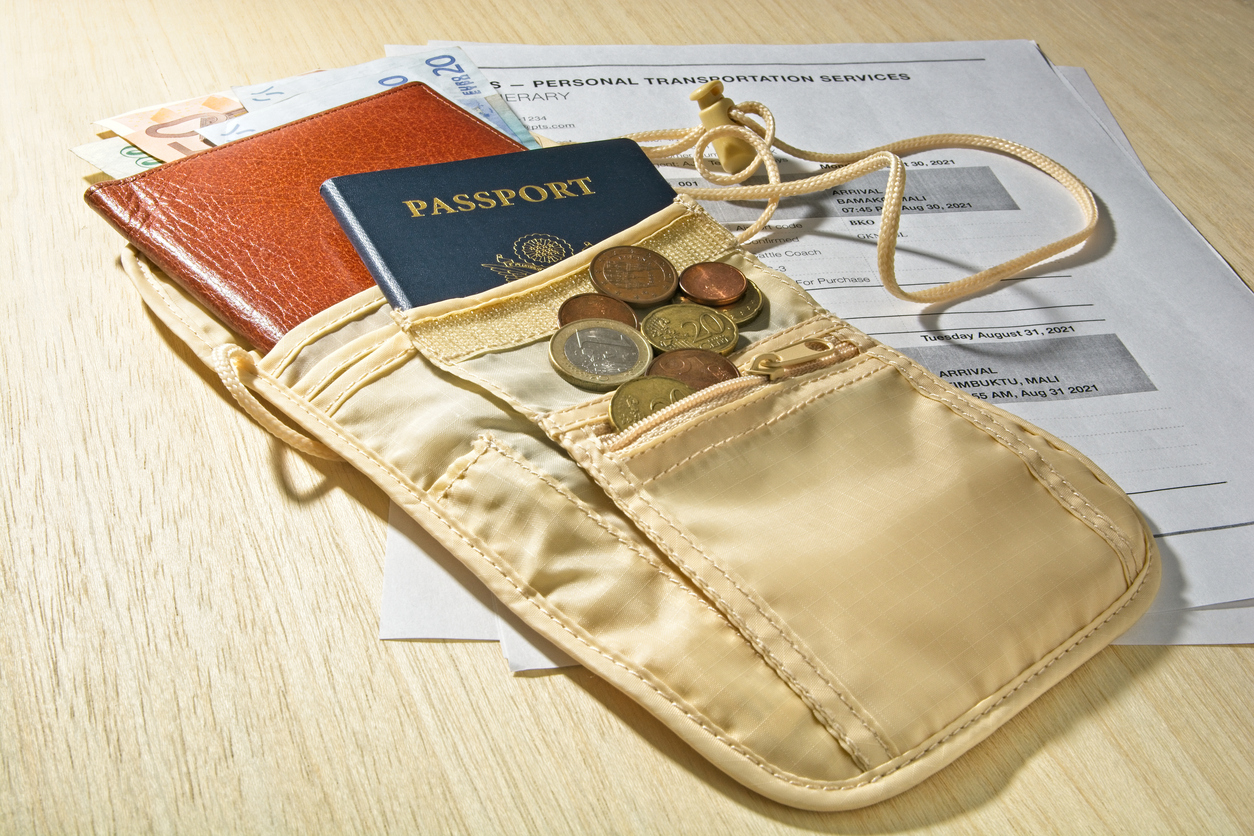


Comments Off on What to Know Before You Go: Andalucia Edition